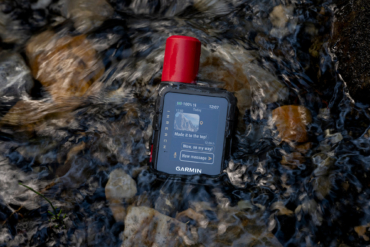Which satellite network will Apple employ and how can users activate it in an emergency? iPhone owners’ burning questions now have some answers with the launch of its own off-grid communication system.
When Apple announced the iPhone 14 and 14 Pro in September, it also announced an intriguing new service called Emergency SOS via satellite. Essentially, the service allows the company’s latest smartphones to send short messages using satellites where cellphone coverage isn’t available. This could make these devices an essential tool for use in the backcountry and disaster zones.
Unfortunately, the service wasn’t yet operational when the new iPhone went on sale, but Apple promised it would be coming in November. And today, the communication system is up and running in the U.S. and Canada, with the U.K., France, Germany, and Ireland soon to follow.
So, how does the system work, and what does it mean for backcountry travel? Read on to find out.
iPhone 14 Satellite SOS

When creating the iPhone 14, Apple added a Qualcomm X65 cellular modem to its design. This is the chip that connects the phone to high-speed 5G mobile networks, but it can also send and receive data using Band 54, a proprietary broadcast frequency used by a company called Globalstar.
When combined with Apple’s custom hardware and software, the iPhone 14 and 14 Pro can transmit short, emergency SOS messages even when traditional cellphone and Wi-Fi networks aren’t available.
In September, Globalstar, which operates a satellite voice and data network that covers much of the planet, shared some insight into its partnership with Apple. In a filing with the SEC, the company revealed that the iPhone manufacturer would take up to 85% of its network capacity to operate the new service.
That network currently consists of 24 satellites in low-earth orbit and communicating with multiple relay stations on the ground. This enables devices like sat phones, GPS messengers — and now the iPhone — to communicate from some of the most remote places in the world.
“The launch of Emergency SOS via satellite direct to iPhone is a generational advancement in satellite communications,” Globalstar executive chairman Jay Monroe said in a press release. “We are proud that our satellites and spectrum assets will play a central role in saving lives.”
Investing in Infrastructure
Apple’s efforts to add this new functionality to the iPhone go well beyond designing a custom chipset and finding a reliable satellite communications partner. To make this service as robust and reliable as possible, the tech giant is investing $450 million to help Globalstar improve its existing infrastructure.

Those funds will increase overall capacity and upgrade not just the satellites in orbit, but also relay stations on the ground. That investment also creates 300 new jobs at Globalstar, which is staffing up to monitor and maintain the service.
Globalstar will use much of the influx of cash from Apple to upgrade its existing ground stations in Texas, Alaska, Florida, and Puerto Rico while bringing on two new stations in Nevada and Hawaii.
Those facilities are now outfitted with high-powered antennas designed specifically to receive transmissions sent from iPhones. The ground stations can then convert that data into text messages that get forwarded to emergency services located close to where the emergency SOS was transmitted.
Unfortunately, not all emergency service centers can receive text messages. Should an emergency message come in from an area that doesn’t have that ability, it will route to Apple instead. The company is building a response team of its own to handle those situations and will contact local authorities to relay the necessary information to initiate a rescue.
“We are proud this service is enabled by leading US companies,” Apple chief operating officer Jeff Williams said via a prepared statement. “Our users can explore off-the-grid areas knowing they are still within reach of emergency services if they are in need.”
Apple Satellite Comms: How It Works
Since the Emergency SOS via satellite service was first announced, details of how it works have become clearer. The service automatically activates when an iPhone 14 owner attempts to initiate an emergency call from a location where cellphone or Wi-Fi service isn’t available.

Under those circumstances, the device will ask the user if they want to send a message using the phone’s satellite connectivity instead. If they say yes, the phone will start the process of creating and sending that message.
The process begins by asking the iPhone user to answer a few simple questions via an onscreen questionnaire. Those questions help gather vital information — such as the nature of the emergency and the seriousness of the situation — which can assist the response team. It also simplifies the amount of data transferred, speeding up the transmission time.
After completing the questionnaire, an onscreen prompt helps the user to aim the phone at the best point in the sky to connect with a satellite. A graphic indicates signal strength and when a proper connection has been established.

Once that happens, the questionnaire responses, the user’s Medical ID information, current location, and altitude are sent to Globalstar. From there, a local first responder team receives notification via text message, or the data is passed to Apple to coordinate directly with emergency services.
“We dedicate our lives to helping people in need, but there are inevitably people who are not able to contact a dispatcher. Emergency SOS via satellite will allow us to help iPhone users in more remote areas who might not otherwise be able to reach us,” said Jennifer Kirkland, ENP, the Grand Junction Regional Communication Center’s 911 center manager, in an Apple press release.
“Because this service requires no additional technology for PSAPs [Public Safety Answering Points], and because Apple has implemented a relay center model that 911 operators are familiar with, we can expect a seamless rollout, both for the PSAPs that accept text messages and for those that are still voice-only.”
More Features
For those who are curious about how the new satcom system works, Apple (wisely) created a demo feature. This gives iPhone 14 users the ability to do a test run of the system without actually initiating an emergency response.
It also serves as an excellent way to familiarize yourself with the system should you ever need to use it in an actual emergency.

The new iPhone also allows owners to share their GPS location with others even while traveling off the grid. To do that, users simply launch the Find My app and tap on the “Me” tab. From there, they can swipe up and select an option labeled “My Location via Satellite.”
This will use GPS to triangulate the current location of the phone and provide the opportunity to share it with others. Doing so will transmit the current coordinates to anyone who can track a user’s locational data, displaying it in their Find My app.
While the iPhone 14 and 14 Pro won’t completely replace satellite messenger devices from Garmin or SPOT, it does bring some of that functionality to a device many people already own.
Best of all, the Emergency SOS via satellite service is completely free for the first 2 years. Apple hasn’t announced pricing plans for after that, however, although it is likely to be a nominal fee considering the nature of the service.
Emergency SOS via satellite is live now. If you own an iPhone 14 or 14 Pro, give the demo a look. This could be a service that could come in handy someday, and you’ll want to know how to use it should the need arise.








